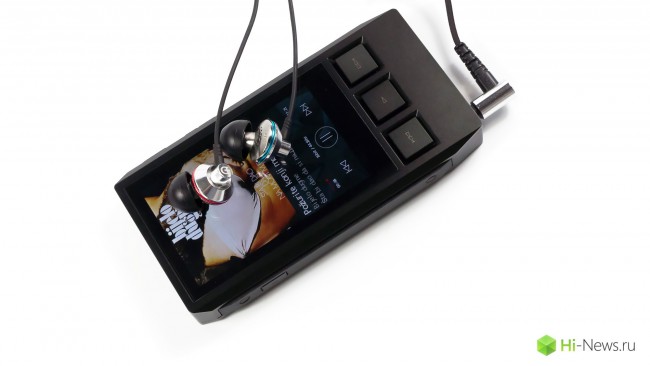
I thought long and hard, as if to avoid the standard introduction to the review, but nothing new could not come up, so you have to start quite corny. The company iBasso with their DX50 and DX90 players deservedly received much popularity among lovers of quality sound. As the time demands of the innovation, the developers decided to update the range, to start releasing the new model received index DX80. That’s about it today, and will be discussed.
Already enough years have passed since then, as the world saw the first player iBasso DX100 with the index. In addition to audio, close to reference, it was the first player with an open Android OS. Also, it featured a considerable size and huge price of 830 dollars, putting it on par with another “legendary brick” HiFiMan 801.
Realizing that some of the top players in the market does not end, the product managers iBasso decided to fight for the budget segment by launching the DX50. She was distinguished by much smaller size, Wolfson WM8740 in the role of codec and bright, detailed sound that has become a hallmark of the company. For “fifty dollars” was followed by the DX90, which houses two ESS Sabre 9018K2M, which led to its higher price. Body same for both models were practically identical, which wasn’t exactly logical considering the price difference, although not really hurt the popularity of the devices.
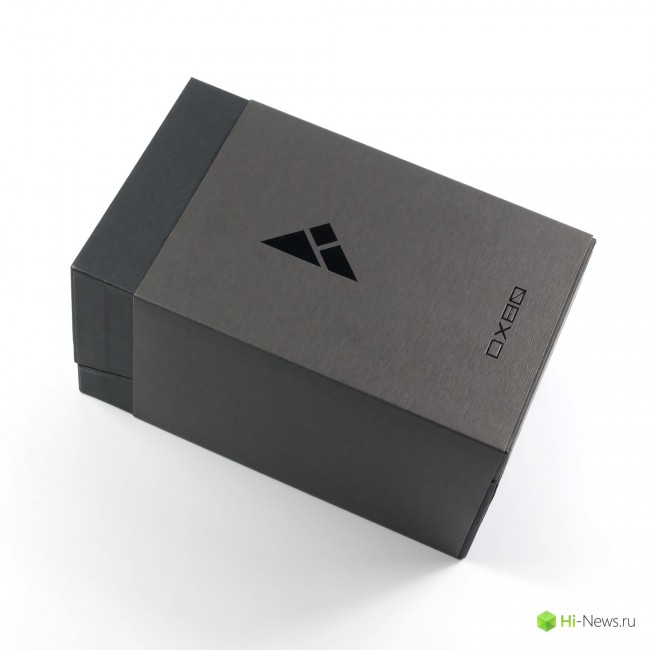
By the time the younger models iBasso DX100 declared obsolete and removed it from production, leaving only the 50 and 90. This continued for more than a year, but it became clear that it was time to update the range.
DX80 appeared quite suddenly, iBasso themselves have posted photos of it on Facebook and stated that details will follow later. In the next couple of weeks they performed his promise, giving out nuggets of information. It became known that the new player will be positioned as something between 50 and 90 models which are being phased out. Inside the device will get a pair of CS4398 DACs, perhaps the most popular chips in modern portable audio player (starting with the mainstream Fiio X3-2 and ending with super expensive Astell-Kern AK240). Not stingy to the rest of the filling, there was a place high-quality capacitors from Nichicon, and two MEMS oscillators from Time Si, and a USB interface for the function DAC that uses a chip from Xmos and Thesycon driver. As a USB DAC player supports resolution up to 192 kHz/24-bit and has “native” support DSD64 and DSD128. The amplifier uses OPA1602 and two chips with erased markings as a buffer (BUF634 or LMH65 presumably).
As usual, to put a neat approach to the iBasso design: 6-layer Board with gold-plated tracks, special shielding to protect from interference, in General everything is done very efficiently.
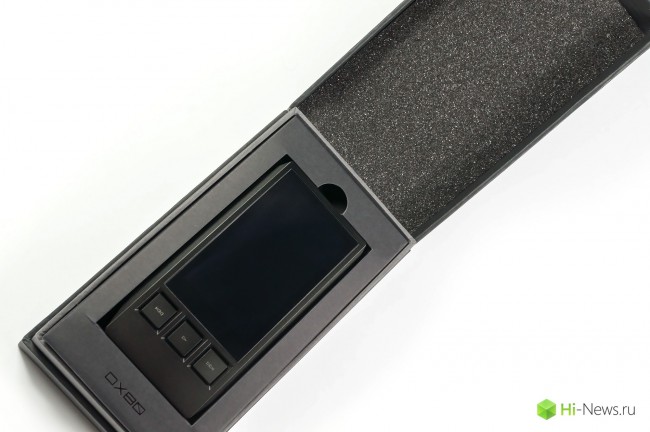
Interface, as before, based on the touch screen, which has grown, now it’s 3.2-inch IPS display with resolution of 480 × 800. Nourishes all this magnificence battery 3600 mA/h.
Individual pleasant bonus was the fact that iBasso appreciated DX80 cheaper than previous top in the face of the DX90, the cost of vosmidesyati is 26 900 rubles in Russia (the site of the official representative company in Russia) and 8075 UAH for pre-order in Ukraine (also the site of official representatives). Naturally, prices are subject to change due to exchange rate fluctuations.
Specifications
- DAC: 2 × CS4398
- SoC: RockChip RK3128
Headphone output (at 32Ω load)
- Frequency range: 17 Hz – 20 kHz ± 0.1 dB
- Output power: 260 mW
- Output voltage: 2,9 Vrms
- The ratio signal/noise ratio: 114±1 dB
- Total harmonic distortion + noise: 0,002%
- Channel separation: 70 dB
Line out
- Frequency range: 17 Hz – 20 kHz ± 0.1 dB
- Output voltage: 1,6 Vrms (1 kHz, 0 dB)
- The ratio signal/noise ratio: 116±1 dB
- Total harmonic distortion + noise: 0,001%
- Channel separation: 107 dB (1 kHz)
Different
- Formats support: APE, FLAC, ALAC, WMA, WAV, AAC, AIFF, OGG, MP3, DFF, DSD, DXD
- Resolution support: up to 192 kHz/24-bit
- Screen: 3,2″ TFT, 480 × 800
- Battery: 3600 mAh, 3.8 V
- Working time on a single charge: up to 13 hours
- Charging time from 2A charger: 3 hours
- Inputs: Micro USB
- Outputs: nauchnikov, linear, optical/coaxial SPDIF
- Memory cards: 2 x MicroSD up to 2 TB
- Dimensions: 120 mm x 63,2 mm × 16.8 mm
- Weight: 178 g
Packaging and delivery package
Above the box in iBasso worked just fine, despite the absence of bonus materials, it looks interesting. Packaging DX80 made from thick black cardboard with cardboard same jacket. Open it diagonally, the player itself is inside on a sloping pedestal. Under this pedestal hides all the accessories. This presentation immediately captivating, setting up a serious attitude to the device.
In addition to the DX80, in the kit you will receive: a pair of protective films on the screen, black silicone case, a cable adapter for coaxial input and know-how iBasso cable to the load to “warm up” the player.
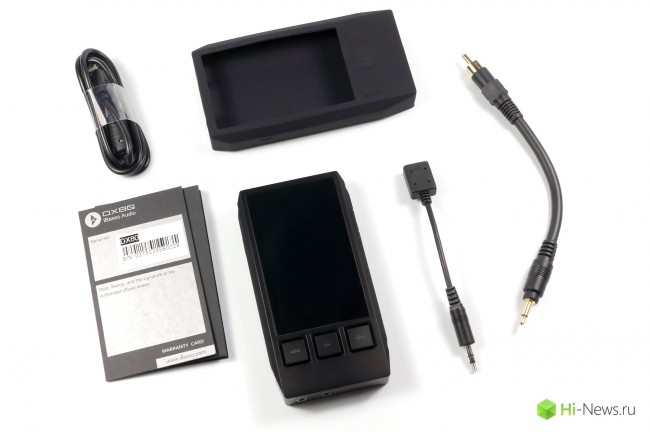
Protective film, by the way, nothing is not glued from the factory, I’ve never been good at this, so the first time I traditionally didn’t work out — some dust on the edges of the film provided the air bubbles. Fortunately, they cover the edges of the case and they are not very noticeable.
Design and management
Appearance DX80 iBasso marks a departure from simple forms, simple parallelepipeds of the previous models in a hurry DX80 complex and multifaceted. A lot of bevels and chamfers in the design of the player gives it a futuristic look, does not resemble any other model. The black casing is mostly made of metal except for the plastic inserts at the sides.
The basic interface supports touch screen, now it has become higher that benefited from the interface. Play/pause and navigation through the tracks is traditional for iBasso buttons under the screen. In the right pane set the volume buttons to adjust digital and has 150 steps. On the left side — the power button and turn the screen on. The bottom has the headphone outputs and line. On top posted the S/PDIF output, MicroUSB connector and cover with two slots for memory cards. The connectors are located close to each other and sunk into the body, so manipulating them will need slightly become accustomed.
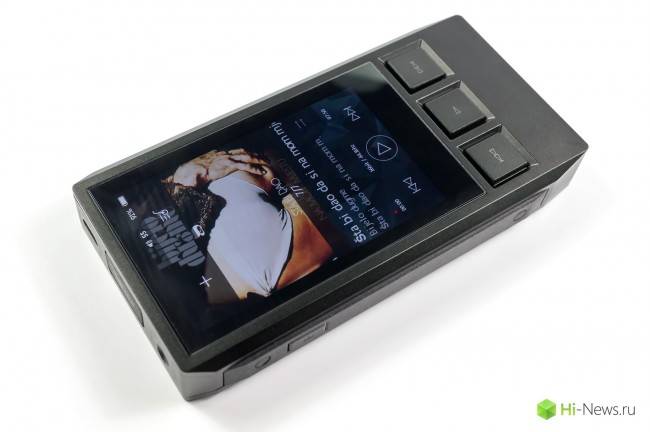
The build quality is very high, do not play, the buttons with a clear click.
Worked in DX80 and on the interface, it is built on the active use of swipes across the screen. Swipe to the right gives access to the library, there are playlists, which can be created right on the device, browsing by genre/album or artist, and navigation by folders. For proper operation of the library need to rescan the memory card, it is a long process (though not as long as the firmware on the first HiFiMan 901). Swipe to the left leads to the settings screen. It has everything what is expected from the player: sleep timer and off time settings and the brightness of the backlight, the choice of gain level, switch the digital filter, play mode, equalizer and more. In the firmware there is an official Russification, but traditionally Russian font is very ugly, so I stayed with English.
Swipe from the top of the screen shows a drop-down menu with quick settings that allow you to quickly change the most important parameters.
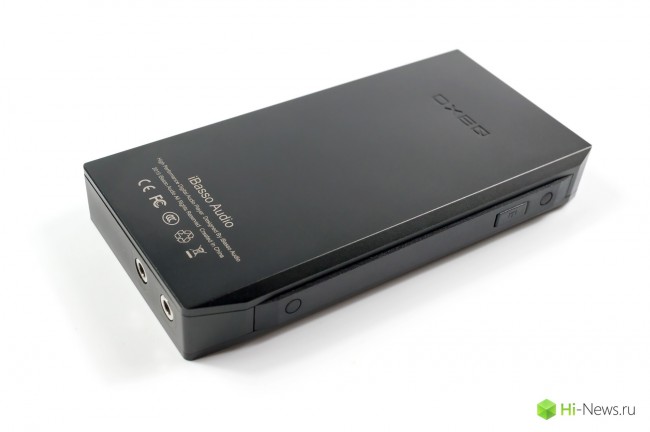
The screen is very high quality, viewing angles and the behavior of the sun is decent, and color reproduction, though the sensor a little slow, but quickly get used to it. I think here the problem is still software, so it can be corrected.
Working time on one charge I was 11 hours and 50 minutes when playing FLAC files with Lear LHD-AE1d on low gain, charging from scratch required a little more than 3 hours.
The sound
To listen to the player we used the following headphones:
- HiFiMan Re600
- ZMF Omni
- Oppo PM-3
- Dunu DN-2000J, Titan 1, Titan 3 and Titan 5
- Lear LHF-AE1d
- Ambient Acoustics AM10
According to the developers iBasso, before listening to the player must be connected to complete “propriately” transactions, and leave it to play for two hundred hours. It is unlikely that this action has any meaning, so I didn’t, but as a player I have already in use for a long time, a common “time” for a long time has exceeded 200 hours, so I can safely assume your player ready for the final assessment of the sound.
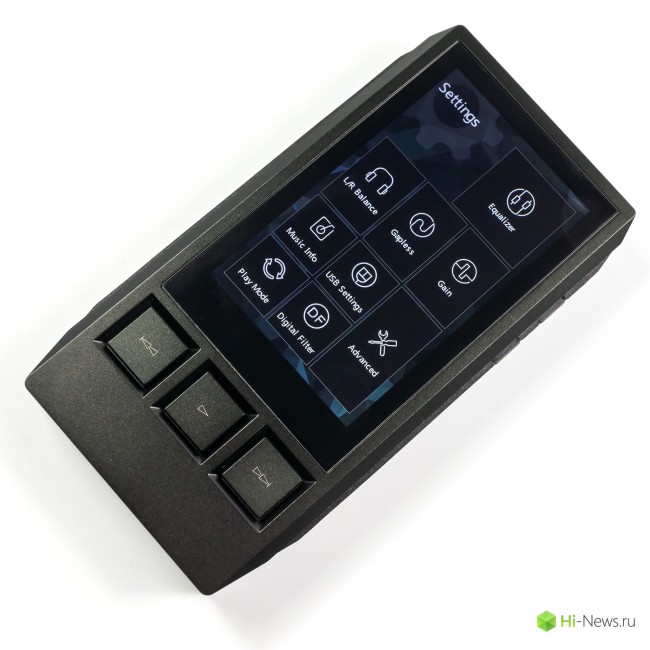
In DX80 developers continue his own approach to the sound that is neutral and impersonal (in a good way) flow. The player makes a maximum, in order not to make a sound, though something of yourself, sometimes, for my taste, pereverseva with it. Slightly exaggerating, one can say that on some tracks the player tries to play neutral so that the sound seems a little muddy because of the “cut” accents. Can’t say that the player takes the music quite emotionless, all the emotions of the record in place, but are perceived as something from the outside. Like you’re not playing the game, and sitting next to a friend who plays (sorry for such a strange analogy, but it’s really hard to describe the whole feeling).
Some reviews on the Internet refers to the coloration of sound, but my hearing is just not the colour and kind of its opposite, like a colour negative, the player does not add anything from itself, but rather removes what. In General, as to call it more depends on your point of view on the issue and personal preference. This effect is small and does not manifest itself on all the tracks, but definitely has a place.
I want to emphasize that this is not so much a drawback as a “feature”, the player is clearly designed to get a similar sound, and it makes it to your taste. Connoisseurs of such sound is clearly there, and the advantages in this technique are (about them below).
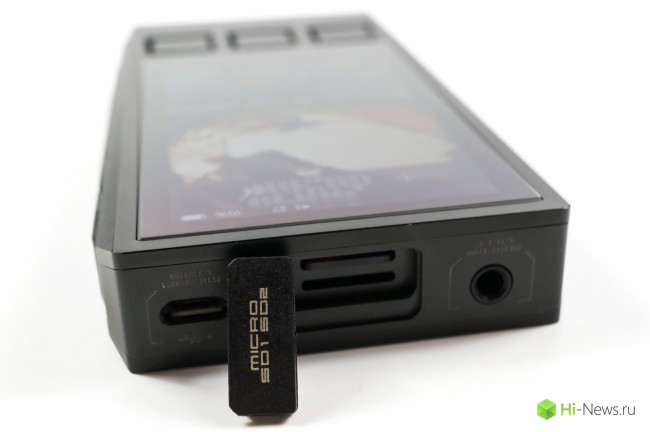
Bass happy resolution, it is well designed and very well controlled. He has good depth, but he sometimes lacks the physicality and percussive density. This is manifested mainly in heavy genres, jazz or the classics, there are no such problems. From positive sides — speed and control allow the player very well to convey complex bass lines, separating them into individual tools. The bass always remains in its place and not trying to crawl on MF.
The midrange is very good, he pleased with the detail and elaboration, although here, too, partially smoothed emotions. In particular this applies to aggressive genres: vocal with growling, guitars with distortion and furious blast beats — not the path of the DX80. The brand of this player — a wide scene with a detailed study in depth, separation of instruments, their positioning on the ear, the transmission of individual peculiarities.
The upper tuning frequency is clearly so as to avoid the slightest hint of brightness, and sharpness. They are quite nice in detail and speed, but is specifically reduced in the flow so as not to bore even on bright headphones. This slightly reduces the perceived pseudocatalase sound, but a little accustomed to the manner DX80, you begin to understand that this does not apply to the real detail.
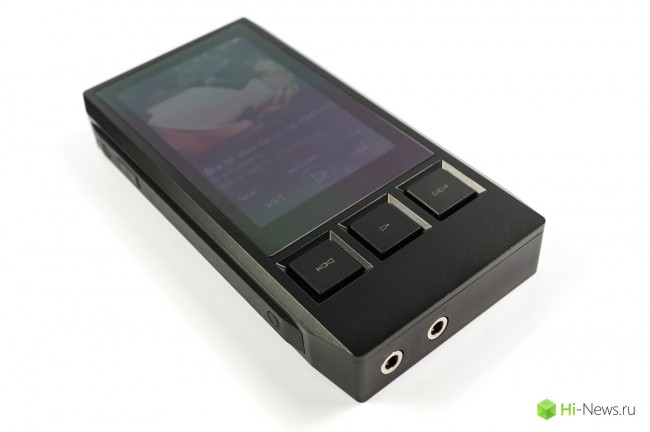
Compatibility
One of the main advantages of this player — he doesn’t tire of their sound with almost any headphones. Even very bright and shock from Dunu Titan 5, which has strongly pronounced V-shaped frequency response, sound with DX80 without kinks. In fact, to use the player with any headphones, the main thing is that you liked their submission and they were not too neutral. The power reserve of a good player, and problems even with headphones does not occur (except in the most tight models).
Genre player is not very in my ear ideal for heavy metal and other genres brutal, where necessary aggression. Although, if used to their pitch, listen to “the strand”, of course, possible. But it perfectly reveals a more tranquil type styles of jazz and classical music, where it is important the construction of the scene and volume. The quality of the recording DX80 very tolerant, somewhere in the 6 to 10 points.
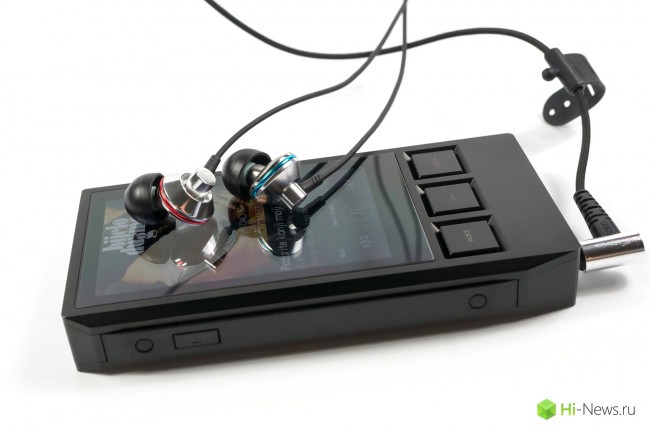
Traditional tracks are examples
Arena — Painted Man. The case when “met two of loneliness”. British geniuses neoprogressive themselves play a fairly aloof music, the main idea of which is the infinite skill of the performers, and then to this is added the same passionless player. The result comes out as a classic: “Believe it. I algebra harmony”. The music is presented in the form of a perfect crystal, which is an interesting turn on the light, marveling at the complex game of reflections in its faces.
Art Zoyd — A drum, a drum. Another case of synergy between player and music. Creativity Art Zoyd full of schizophrenic roughness, sharpness, and unexpected transitions. If you love this group as much as I, and think that madness and genius are closely interrelated things, the DX80 is capable of great increase psychodelicate what is happening. It takes the listener a little away from the musical frenzy of the group, allowing you to see the whole picture in a complex, considering its scale.
David Gilmour — Dancing Right In Front of Me. For me personally it is absolutely clear who Pink Floyd was responsible for the best musical finds, and who for the promotion of socialist ideas. Of course, I’m kidding, but recent solo work of Gilmour is a rare diamond in a heap of musical dross. Paying tribute to the memory of Rick Wright’s last album Pink Floyd “Endless River” and dismissing the group, David said that is not going to look back. And indeed, this album has a lot of charm, for example, noticeable flirting with jazz in this track. Of course, to describe the play of Gilmour is really useless, it is necessary to listen. DX80 is very suitable for this music, allowing to evaluate its depth and complexity to the fullest.
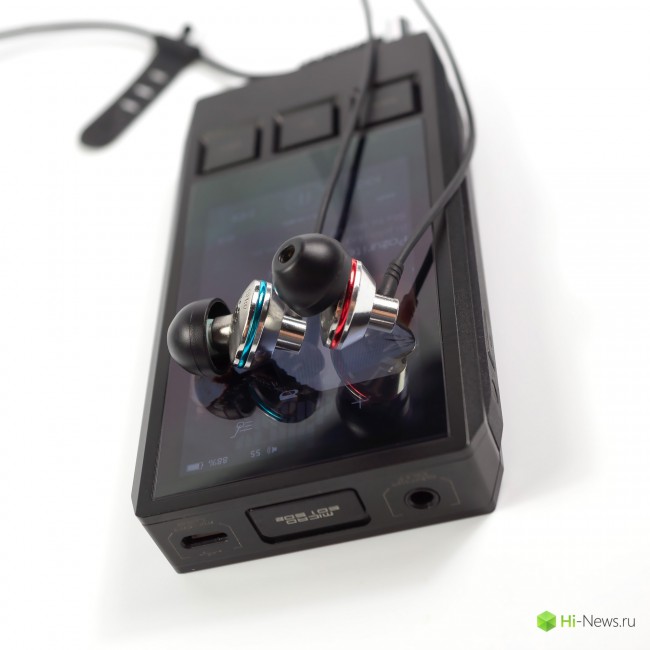
Conclusions
iBasso remain true to their sound. This is bad news for those who does not like him, and good for fans of brand detachment. DX80 with sniper accuracy falls exactly between DX50 and DX90, as the first sign in the recycled mix. Stylish appearance combined it with ease of use, and characteristic signature sound appears in full measure, delighting fans of the company. The price tag is definitely a good player for this level, but before buying you should make sure that such a supply of musical material you are impressed by.
